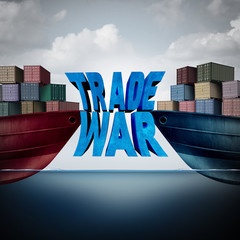As most organizations are realizing, Business Acumen is a critical skill needed to achieve business  success. Everyone has their own definition, and hopefully your organization has a strong program in place that provides it to every employee.
success. Everyone has their own definition, and hopefully your organization has a strong program in place that provides it to every employee.
The other day as I was finishing the review of our Business Acumen learning solutions and fine-tuning the core business simulations we use to teach business acumen skills, I started to listen to the background noise about tariffs and trade wars. I realized we needed to increase the amplitude of these tariff issues in everything we do that’s related to Business Acumen.
As a result of the current geopolitical and business climate, effective July 1, 2018, all of our larger, sophisticated business simulations will have a tariff option as far as the configuration. In other words, we now have the option of imposing special taxes between countries on products and services being sold between regions. The learning for our clients is going to be fascinating!
To craft the scenarios and basic models, we had to do some research and understand the core issues from a Business Acumen perspective. I’ve taken the research and boiled it down to a few critical things to share with readers of this blog as part of our continuous learning efforts to support you.
But before I begin, a quick word about politics. I try very hard to keep these blogs neutral and not bias in any way. These are just the facts and opinions as I see them through the lens of Business Acumen learning.
Here are three important things to know and think about:
There is a lot of Positioning Going On
According to the facts as we all know them; the US economy is thriving and sustainable right now. Consumer confidence is strong, unemployment is at a very low 4.1%, wages are steadily increasing, and as we all know, the war for talent is probably going to be more of a long-term story than a war of tariffs.
So why raise these issues now? In my opinion, it’s the same reason you look for a new job when you have a great job, as opposed to being unemployed; because you can and you aren’t desperate.
Based on the data, I think this all needs to be put into perspective.
If you look at the most macro of macroeconomic data – the Global GDP stands at about $75 trillion which the US makes up about 40% of – the skirmishes over tariffs on steel and aluminum is “only” a $50 billion industry, will have little to no impact on the macro global economy. A lot of the talk, and a lot of the angst, is really nothing more than positioning, negotiating, and trying to level the playing field in a few areas where it’s clearly out of balance. Another industry out of balance because of existing and future tariffs is the soybean industry, where our strong and entrepreneurial companies are at a disadvantage because of high Chinese tariffs. Again, an adjustment here to balance things out is quite justified.
Learning Point: As I think about the simulation models we use to teach Business Acumen, the more we understand that out-of-balance drivers can quickly upset an ecosystem, and so positioning for more balance is definitely a good thing for the long run.
It’s 2018, not 1930
Some of the deep concern about a new trade war are based on lessons learned after a series of events that included the crash of 1929, the Great Depression of the 1930s, and then World War II in the 1940s.
Many believe that it all began with a disastrous piece of legislation called the “Smoot-Hawley Act,” which essentially imposed tariffs on thousands of products, and set into action a trade war between all nations. There are many voices in the world today that are saying the events of those two decades were triggered by protectionism and isolation tactics that feel eerily similar to what we are seeing today. While we should always learn from history, it’s important to understand this is a completely different world. Technology has created a collaborative, integrated world, and the global economy is simply too united to become undone quickly or because of political rhetoric.
Learning Point: The current world is more united and integrated than we realize and more importantly, there isn’t an easy way to uncouple it (nor does anyone really want to do that anyway).
The Real Fear Should be about Global Inflation
Here comes the first mention of the dreaded “I”-word; inflation. The real fear we should all have from a Business Acumen perspective is the fear of inflation. If inflation goes up, interest rates will go up, and then we will have a real problem. However, this integrated global economy is very different than it was in the late 1970’s when inflation crippled the economy. Back then, the trigger mechanism was the oil crisis. But today, the United States is much more self-reliant, and we produce more oil than any other country. In addition to oil, we have more natural resources, food products, technology, and better health care. That’s all good news when it comes to tariffs, as the US could sustain itself for decades of economic growth without needing to negotiate away or live with extreme and unfair tariffs. Since we are so strong, there is a lower likelihood of entering a recession.
Learning Point: Inflation can hurt everything and anything. While bluster and positioning are part of negotiations, it’s important to keep our eyes on the drivers of inflation and keep them calm.




